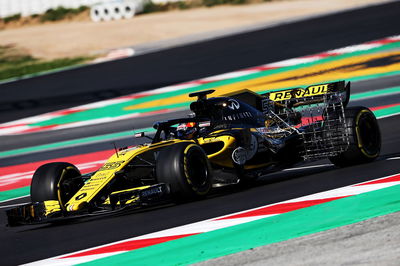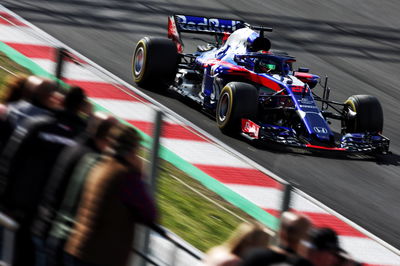F1 Testing Analysis: Deciphering the clouded midfield picture
As Formula 1 pre-season testing came to a close on Friday in Barcelona, it was Ferrari who once again stole the headlines as Kimi Raikkonen finished more than one second clear of the field.
A fastest lap time of 1:17.221 gave Raikkonen top spot by 1.1 seconds, and while he finished two-tenths of a second off teammate Sebastian Vettel’s track record, it was still a clear statement of intent from the Prancing Horse.

As Formula 1 pre-season testing came to a close on Friday in Barcelona, it was Ferrari who once again stole the headlines as Kimi Raikkonen finished more than one second clear of the field.
A fastest lap time of 1:17.221 gave Raikkonen top spot by 1.1 seconds, and while he finished two-tenths of a second off teammate Sebastian Vettel’s track record, it was still a clear statement of intent from the Prancing Horse.
Yet as our analysis of the race simulations completed on Thursday showed, it is Mercedes who appears to have the edge across long runs. Even with Kimi Raikkonen’s data from today included, Valtteri Bottas’ race simulation seems to be the benchmark.
While the ‘big three’ may remain untouched at the front of the pack for the new season, the midfield battle offers a far more nuanced and difficult picture to decipher.
Renault was the early paddock favourite given its significant investment and recruitment drive ahead of its third season back as a works outfit, and the French marque has looked solid for much of pre-season testing.
However, it hit trouble early on Friday when Carlos Sainz Jr. was forced to park his car with just four laps on the board due to a gearbox issue that the team was investigating. He would not return to the track for another six hours, eventually finishing with just 45 on the board - but posted the third-fastest time of the day to put him P5 for the winter.
Following an otherwise-impressive test in terms of mileage, Renault may be ready to sit fourth-fastest come Melbourne judging by paddock consensus.
The bigger reliability story of the day came courtesy of McLaren. Following issues on Tuesday and Wednesday, the team bounced back by enjoying its most productive day of pre-season on Thursday as Stoffel Vandoorne completed 151 laps, offering a boost heading into Fernando Alonso’s return to the car on Friday.
Yet any hopes of a trouble-free day quickly dissipated. On just his seventh lap of the day, Alonso ground to a halt in exactly the same spot as he did on Wednesday after suffering an oil leak. This time around, it was a turbocharger issue that had caused the car to conk out, but once again a power unit change was required. Alonso hitched a ride back to the pits before entering McLaren’s hospitality where his manager was, simply saying: “Engine… five laps…”
McLaren only conducted its first Renault power unit change earlier this week, taking six hours to make the switch. This time around, Alonso was back out on-track a little after four hours on the sidelines, and ultimately racked up 93 laps for the day. It wasn’t enough to stop McLaren finishing comfortably bottom of the mileage rankings for pre-season testing, though. A late glory run saw him rise to second for the day on the Hypersofts, being just the third driver in testing to dip into the 1:17s.
In terms of pace, McLaren appears to have confidence in its concept and the car. Racing director Eric Boullier kept using the word “ambitious” when describing the MCL33 chassis, perhaps trying to justify the issues that limited its running. In terms of raw data so far though, it’s hard to really peg where McLaren is - something even Boullier acknowledges.
“We are trying to guess where we are,” he said. “It's difficult to understand because of the tyre situation, the temperatures, engine mode, fuel load - it's more complex this year than ever.
“It looks to me there are some teams who progressed well like Haas and Renault. I think the fight at the front will still be between Mercedes, Ferrari and Red Bull. The pack got closer, and we believe we belong in the middle of this one.”
The midfield glut towards the end of last year featured Force India, Renault, Williams, McLaren, Toro Rosso and Haas, and the trend shows little sign of slowing down this year. As the regulations mature, convergence is to be expected, meaning the fight could just get closer and closer.
“Every team seems to have done a great job over the winter, there’s some great cars out there and most of them are going very well,” Williams technical chief Paddy Lowe said.
“I also see a lot of different innovations as well. There’s often talk about Formula 1 running out of new ideas or the cars being too much the same but I see quite a lot of interesting, different ideas on the different cars, which is great. So what I think it’s going to lead to is a pretty close competition.”
Deputy team chief Claire Williams echoed her colleague’s sentiments: “I think there's going to be a big fight in that area of the field throughout the championship. I think it's going to be really tough. I think it's going to be difficult for the teams.
“I think the development war is going to be more intense than it has ever been because of that midfield level of competition. But I think for the fans of our sport, it's going to be great. I think it's going to be a tough old year in our sport.”
When it comes to a development war, it is likely to be the better-funded, better-resourced teams that come to the fore. But in the early part of the season, there could be a more surprising team that could emerge towards the head the midfield pack.
Haas made a big step up through its second season despite being tasked with building an all-new car alongside adjusting to life in the sport. While a little inconsistent, the American outfit was regularly part of the midfield scraps, even leading on occasion at races such as Austria.
Kevin Magnussen made a splash by finishing an impressive second for the team on Thursday, but was quick to warn against getting too lofty with the team’s ambitions despite posting his time on Supersofts, with most of the cars around him managing their times on Hypersofts.
Romain Grosjean underpinned Magnussen’s pace with another impressive run for Haas, spending much of the day P2 before late runs eventually shuffled him down to fifth. But again, he did not complete his time on the Hypersofts, with the team electing not to bring them to testing - just like Mercedes.
When asked by Crash.net if he was looking to cool expectations a little bit after Magnussen’s pace, Haas team boss Günther Steiner simply said: “Yes!” before laughing with a big smile on his face. Even he can’t conceal that, in terms of pace, this has been a decent pre-season for the American team.
"I think we've got as much out as we could of the last two days," he added. "We didn't leave a lot out there. The first two days were little bit compromised, but not a lot. Last week it was the same for everybody, bad weather, what can you do about it?"
There looks to be a bleaker picture for Williams, though. The team finished bottom of the timesheets on six of the eight days of testing, and all three of its drivers featured in the bottom six overall. The car looked really skittish on-track and struggled on the softer tyres. Lance Stroll was sent out late on Friday to try and get in some short runs, but could only just about improve to a 1:19.954 - still putting him bottom of all though…
“The limitation in the car at the moment is corner entry instability,” explained Lowe. “That’s quite often the limitation in the car to be honest, but it’s particularly exaggerated at the moment with what we’re running. If we can unlock some progress there we will find a lot more lap time than we’ve got at the moment because some other aspects of the car are working really, really strongly through other phases of the corner.”
Force India managed to bounce back from a difficult start to testing to rack up a high number of laps over the final test week, showing a solid pace. While Esteban Ocon’s claim the team is “not far off” Red Bull is perhaps a bit fanciful, a place in the middle of the pack is looking on the cards.
Toro Rosso arguably had the most successful pre-season testing of all in Barcelona, enjoying a trouble-free start to life with Honda. While the lap times are again difficult to read too much into, Brendon Hartley came away confident it would be in contention for points come Melbourne.
“I think we are really in the mix,” Hartley said. “Obviously we can’t tell you what fuel loads we are on but I think we are really in the mix for that midfield battle, which is really fierce. Like it was last year as well. It’s been a great start to the partnership with Honda so I think everyone is really positive after these test days and I’m looking forward to going to Melbourne.”
Sauber once again seems to be propping up the running order, but not a million miles off as it was last year. The regular offs during testing didn’t help its cause. Nevertheless, the team has its eyes firmly set on building a long-term project, not hitting the pace immediately.
In terms of gauging a pecking order, a rough idea may be as follows:
1. Mercedes
2. Ferrari
3. Red Bull
4. Renault
5. Haas
6. Force India
7. Toro Rosso
8. McLaren
9. Williams
10. Sauber
Ferrari and Red Bull are evenly-matched, while Renault seems to be sitting as the best of the rest. Haas could be heading up a tight thick of the midfield with Force India and Toro Rosso in close pursuit. McLaren seems to be in that battle too, and some rapid gains over the season, once it is on top of its problems, could vault it up the order. Williams and Sauber look to have the most work to do, though.
Until we see the cars hit the track in anger for the first time though, we’ll continue to speculate. The final preparations have been made.
Next stop? Melbourne, Australia.











